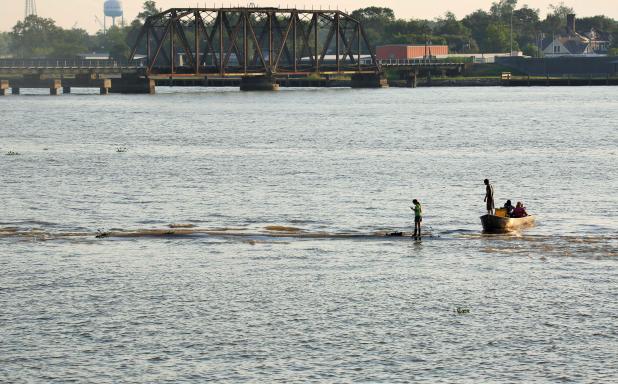
The Daily Review/Bill Decker
After boating to the sandbar in Berwick Bay near the Morgan City wharf Monday, this young woman takes a selfie.
River drops, but now sandbars are a problem
For the first time in about a year, Coast Guard Cmdr. Heather Mattern could tell the Port of Morgan City board that as of Monday, the Atchafalaya River is no longer considered to be at a high-water stage.
Now a different problem has surfaced: shoaling.
“There’s islands popping up all over,” said Mattern, who commands the Coast Guard's Marine Safety Unit Morgan City.
At the Morgan City Harbor and Terminal District board meeting, members talked about sandbars that have appeared in the river. The most visible of them, easily seen from the U.S. 90 bridge, is in Berwick Bay near the Morgan City wharf and north of the railroad bridge.
The sandbars are a reminder of how much sediment has been deposited in the river during high water. Pictures of sandbars have become popular on local Facebook accounts.
Mattern said the problem is more pronounced near 20 Grand Point and other local other areas.
A question from the audience was about whether Coast Guard vessels would continue to shadow traffic between Tidewater Point and 20 Grand Point, a process that can slow the flow of cargo.
Mattern said a mishap might slow traffic even more.
A ship running aground could block the channel for several days, she said.
The Coast Guard has let the U.S. Army Corps of Engineers know that the sandbars are a priority for dredging, Mattern said.
The port board’s efforts to keep area waterways open for commercial traffic have come to resemble a game of whack-a-mole. After years of efforts to obtain more funding for dredging, the board learned last year that it would receive more than $40 million over two years for dredging.
Sediment deposited by the river has prevented some traffic, including import-export shipping.
A 2017 study found that having the bar channel maintained to 20 feet deep, 365 days a year would have an annual economic impact of at least $137 million and up to $270 million.
Then came the high water.
Board Chairman Joseph Cain expressed a hope that material removed by dredging could be moved to land rather than dumped elsewhere in the waterways.
While most of Louisiana’s coastline is being eroded, the mouth of the Atchafalaya is actually adding new land as sediment filters out there.
“It would be beneficial to the landowner, to the port …,” Cain said.
“There’s lots of material to be had, I guarantee you,” said Executive Director Raymond “Mac” Wade. “There’s millions of yards of sand in the bay.”
One side effect of the recent water conditions is that the boat carrying officials, including members of the Mississippi River Commission, for their annual tour down the river couldn’t get to Morgan City.
So Wade was offered the chance to make the case to a captive audience for improving conditions near the port, said Economic Development Manager Cindy Cutrera.
Some officials representing other interests along the Gulf Coast have pushed for more water to be diverted from the Mississippi into the Atchafalaya through the Old River Control Structure, Cutrera said.
“We made it clear that we don’t need more water or sediment coming through the Old River complex,” Cutrera said.
